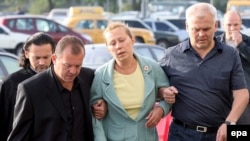Investigators are still working to determine what may have brought down the Russian airliner, which was en route to St. Petersburg from the Russian Black Sea resort of Anapa when it crashed about 45 kilometers north of Donetsk. However, officials are focusing on poor weather conditions as the principal factor.
A spokesperson for Russia's Emergency Situations Ministry said on August 22 that a preliminary investigation indicated that the plane, a Tupolev Tu-154M, had been struck by lightning.
That possibility cannot be ruled out, said Robert Myasnikov, one of the designers of the Tu-154 series. However, Myasnikov, who said he is "upset" by reports that lightning was the cause, insists the plane was well-equipped to cope with storms.
"If there was no serious neglect [on the part of the crew], it was not possible for lightning to strike it," he said. "There is a radiolocation section named 'Storm' on the plane; this section allows [pilots] to see a storm in the way of a plane before entering it, and to evade it."
According to planecrashinfo.com, a website that compiles statistics on plane crashes, only 13 commercial airline crashes since 1938 have been attributed to lighting strikes. The last was in 2000, in China.
A spokesperson for Russia's Transportation Ministry told Interfax that the plane disappeared from radar screens after reporting that it had encountered heavy turbulence at an altitude of about 11,000 meters.
The investigation has been aided by the discovery of "black boxes" of the plane, which should go some way to explaining the course of events.
Ukrainian Emergency Situations Ministry spokesman Igor Krol said the plane's landing gear failed to deploy normally as it attempted to make an emergency landing, and the aircraft crashed "on its belly."
Russia's Safety Record Again Open To Question
The crash, which involved one of Russia's most reputable air carriers, Pulkovo, has cast further doubt on the state of Russia's airlines.
The lack of unified regulations and an influx onto the market of new carriers has contributed to a patchy air-safety record in the former Soviet Union following the collapse of communism.
In recent years, Russian airliners had shown an improvement in terms of safety, but doubts have reemerged of late. The August 22 crash was the third major aviation tragedy in Russia this year.
In July, a Sibir Airlines Airbus A-310 crashed after veering off the runway in Irkutsk, killing 122 people. The accident was blamed on a technical malfunction.
On May 3, an Airbus A-320 belonging to the Armenian airline Armavia crashed on its way to Sochi, killing 113 people. That disaster was attributed to bad weather.
There have also been a number of other incidents this year involving Russian-operated planes.
Many of the concerns about safety standards center on the country's ageing fleet of commercial aircraft. The hundreds of three-engine Tu-154s built since the late 1960s make up a major part of that fleet, and are commonly used by airlines in the former Soviet Union, as well as in Iran.
Tupolev launched the newest model of the airliner, the 154M, in 1982, and construction of the model continues today. This year Tupolev has received orders to deliver five of the planes to China.
Prior to the crash, there had been just one serious accident involving a plane operated by Pulkovo Airlines, the third-largest passenger carrier in the country.
In July 2002, an Il-86 crashed immediately after taking off at Moscow's Sheremetyevo Airport. There were no passengers on the plane, but 11 crew members were killed.
The airline's deputy head, Vasily Nalyotenko, told Reuters television today that the jet that crashed on August 22 was in "optimal working condition" and, with 24,215 flying hours on the clock, was well below the average (30,000 hours) for "such a plane."
RFE/RL In Russian

UPDATED CONSTANTLY: Visit RFE/RL's Russian-language website, featuring news, analysis, features, streaming audio, and more, in Russian, from RFE/RL's Russian Service.









